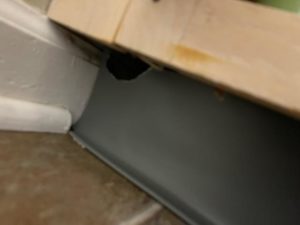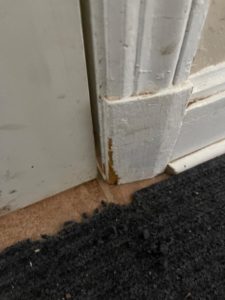Chew holes from rats are a common sign of their presence. That’s why it never ceases to amaze me that people who have rats are surprised when we confirm their suspicions. In fact, most people stay in denial for a while before they call in professional help.

If you’re not recognizing chew holes from rats then look for and compare the droppings you find. Mouse droppings are all mostly the size of the tip of a sharp pencil.
Gnaw marks at the bottom of a door is a sign of rats
You wake up one morning and notice wood shavings on the ground below the bathroom door. After investigating further you see that the rug has also been chewed. While certainly this could be any type of animal the likelihood is that it’s a rat. The reason is that rats commonly exhibit this behavior to gain access to food and water in another room once inside your home.
Finding chew holes in your home from a rat can also give you some idea of where the rat came from. For instance, the picture below

shows gnaw marks on the corner of the baseboard and rug. This rat was trying to gain access to the bathroom from the hallway. This was confirmed because the crawl space below the bathroom had heavy evidence of rat droppings (poop). If you really examine gnaw marks it can also show you if the rats were coming or going and in which direction. A mouse can also do this too, but it’s rare.
The most common mistake people make when trying to catch rats on their own
Rats don’t have the same behaviors as mice. They’re so different that if you foul up the trapping process at the beginning a rat may avoid traps for the rest of it’s life.
The Norway rat, which is the common rat in Connecticut is very shy. When trying to catch them you must NOT set the trap immediately. You must use a method called prebaiting. Prebaiting, as it’s called in the pest control industry means that a trap is baited with the food of choice, but not set. After the rat has taken the food and is comfortable with the trap you’ll have a better opportunity to catch it.
Of course there’s a lot more to catching rats than that, but this is a place to start.
Can a CT exterminator like Envirocare Pest Control get rid of rats?
Absolutely and we enjoy the process of diagnosing and setting up rat management programs both commercial and residential. When setting up a control program we have many tools at our disposal. They include:
- Pet and kid safe (safer) traps
- Tamper resistant bait stations
- Low risk rodenticides
- Tracking powders
- Liquid baits (these work well for Norway rats as they need one once of water per day)
In the end recognizing that you have a rat issue vs a mouse issue is the first step. The most obvious method is looking at the droppings. If they’re pencil tip size it’s a mouse any bigger and it’s more than likely a rat.
In some cases it could be a grey or flying squirrel, but these animals are usually confined to the attic (in unusual circumstances they can be in a living area).
If you have rats or think you might have rats and need help call Envirocare Pest Control at 1-888-879-6481.
